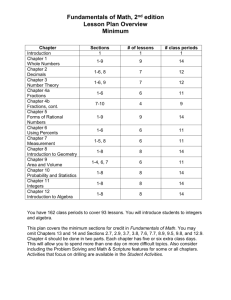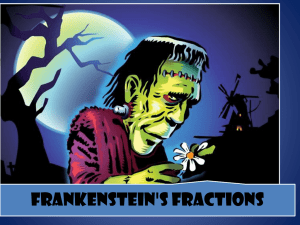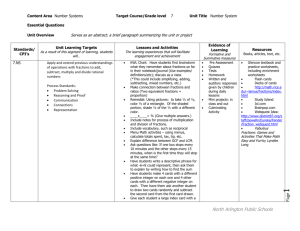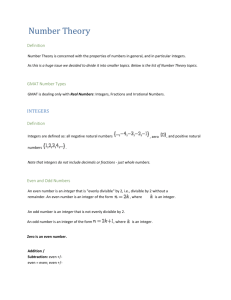Chapter 3 Notes - Clinton Public School District
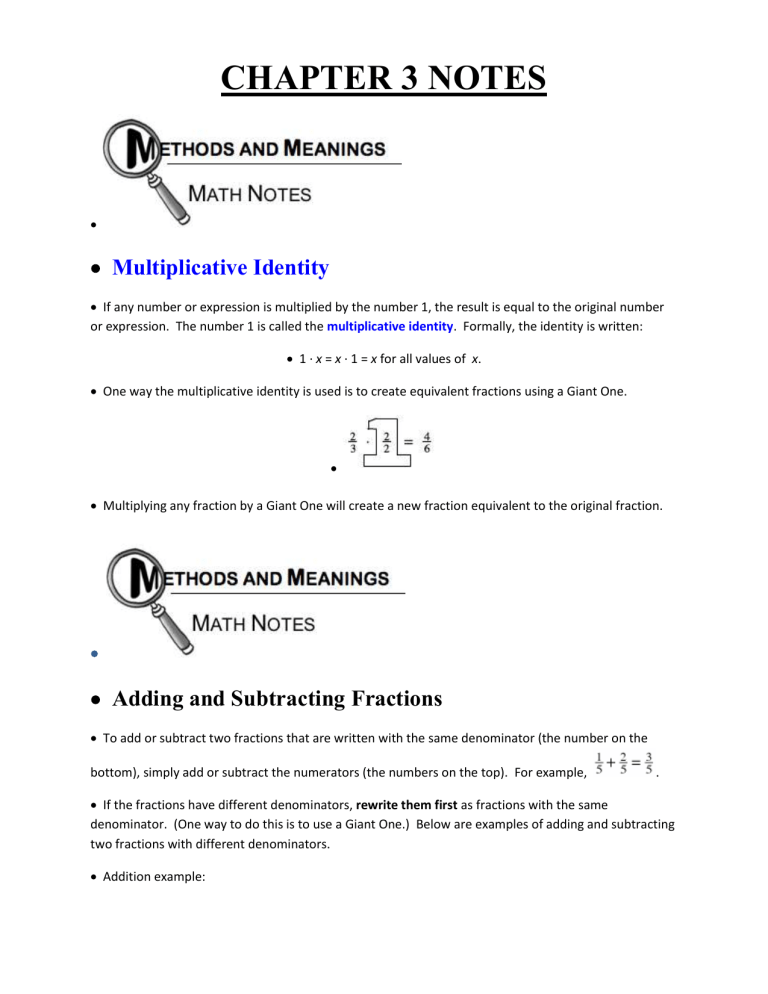
CHAPTER 3 NOTES
Multiplicative Identity
If any number or expression is multiplied by the number 1, the result is equal to the original number or expression. The number 1 is called the multiplicative identity . Formally, the identity is written:
1 · x = x · 1 = x for all values of x.
One way the multiplicative identity is used is to create equivalent fractions using a Giant One.
Multiplying any fraction by a Giant One will create a new fraction equivalent to the original fraction.
Adding and Subtracting Fractions
To add or subtract two fractions that are written with the same denominator (the number on the bottom), simply add or subtract the numerators (the numbers on the top). For example, .
If the fractions have different denominators, rewrite them first as fractions with the same denominator. (One way to do this is to use a Giant One.) Below are examples of adding and subtracting two fractions with different denominators.
Addition example:
Subtraction example:
Using algebra to write the general method:
100% Blocks
Base Ten Blocks can also be used to represent percents. The three basic blocks represent
100%, 10%, and 1%, as shown below.
A percent is a way of expressing a number as a fraction out of 100. In the example shown at right, 23 out of 100 squares are shaded to represent 23%. 23% can be expressed as , 0.23, or twenty-three hundredths.
Percents
A percent is one way to write a portion of 100. It can always be written as a fraction with a denominator of 100 and/or as a decimal.
The Representations of a Portion web diagram below illustrates that fractions, decimals, and percents are different ways to represent a portion of a number. Portions can also be represented in words, such as “four-fifths” or “twelve-fifteenths” or with diagrams.
The examples below show how to convert from one form to another.
Graphing Points on an xy-Coordinate Grid
Numerical data that you want to put on a two-dimensional graph is entered on the graph as points .
The graph has a horizontal number line, called the x-axis , and a vertical number line, called the y-axis.
The two axes cross at the origin (0, 0) which is the 0 point on each axis.
Points on the graph are identified by two numbers in an ordered pair . An ordered pair is written as (x, y). The first number is the x-coordinate of the point, and the second number is the y-coordinate.
To locate the point (3, 2) on an xy-graph, first start at the origin. Go 3 units to the right (to the mark 3 on the horizontal axis). Then, from that point, go 2 units up (to the mark across from 2 on the vertical axis).
The example graph at right shows one of the four regions of the
xy-coordinate graph.
Opposites
The opposite of a number is the same number but with the opposite sign (+ or –). A number and its opposite are both the same distance from 0 on the number line.
For example, the opposite of 4 (or + 4) is −4, and the opposite of −9 is −(−9) = 9 (or + 9). The opposite of 0.5 (or +0.5) is −0.5.
The opposite of an opposite is the original number.
Examples:
The opposite of the opposite of 5 is −(−(5)), or 5.
The opposite of the opposite of −3 is −(−(−3)), or −3.
The opposite of zero is zero.
Least Common Multiple
The least common multiple (LCM) of two or more positive or negative whole numbers is the lowest positive whole number that is divisible by both (or all) of the numbers.
For example, the multiples of 4 and 6 are shown in the table at right. 12 is the least common multiple, because it is the lowest positive whole number divisible by both 4 and 6.
4 8 12 16 20 24 28 32
6 12 18 24 30 36 42 48
Adding Integers
Integers are the positive and negative whole numbers and zero. On the number line, think of integers as “whole steps or no steps” in either direction from 0.
One way that integers can be combined is by adding, which can be thought of as walking on a number line. If you walk one step left (–1), and then one step back to the right (+1), you end up in the same place as you started. This is represented on the number line as –1 + 1 = 0. A number and its opposite, like 5 and –5, are called additive inverses , and their sum is zero (0).
To add integers on a number line, mark the position of the first integer, and then move the number of units indicated by the second integer. Move to the right for positive integers and move to the left for negative integers. Examples are provided below.
Example 1: −5 + (2) = −3
Example 2: −6 + (−2) = − 8
Absolute Value
Absolute value represents the numerical value of a number without regard to its sign. Absolute value can represent the distance on a number line between a number and zero. Since a distance is always positive, the absolute value is always either a positive value or zero. The absolute value of a number is
never negative. The symbol for absolute value is two vertical bars, . For example:
and

